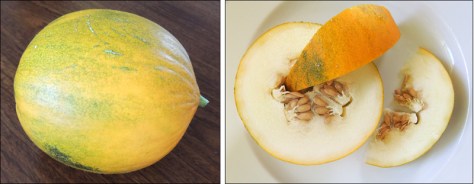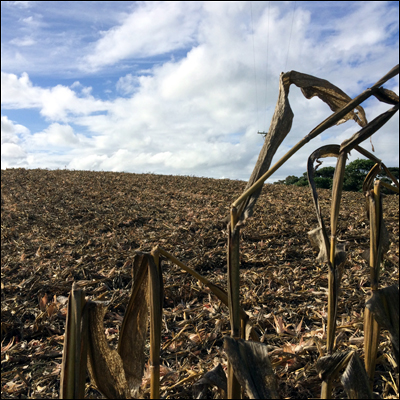
From Sweltering Summer to Temperate Autumn
The maize along the fenceline is ready for harvest. It’s a visual reminder that summer is over. The days are slow to lighten and early to darken, and the grass is thick with dew when I make my way to the barn in the early morning. The gravel road is dry and whenever a large truck rattles by, great dusty clouds drift across to settle on our solar panels.
It’s been several weeks since I’ve written about South Head. Or about anything, for that matter. It’s been difficult to knuckle down to writing after taking time off over the Christmas/New Year period.
While it’s been a very long and hot summer, we’ve also had a decent amount of rain, which of course has meant that everything has just kept on growing. We’ve created enough gardens here to keep us busy every daytime hour, and for the first time I’ve been wondering if it’s too much. What with the dead-heading, the trimming, the watering, the sowing, the harvesting… not to mention the tying, the squashing (caterpillars), the sampling, the digging and the weeding, always the weeding. (It’s making me exhausted all over again, writing about it.)

So… we’ve mostly been home over the weekends slaving away in an attempt to keep everything under control, with a couple of diversionary breaks visiting the local A & P Shows – I like to check out the poultry while Ben looks longingly at the tractors. 🙂
Bounty from the Garden

Since I last blogged we’ve harvested a parade of fresh produce, including grapes, lettuces, carrots, rhubarb, cannellino beans, sweet basil, garlic, cucumbers, peas, beans (green, yellow, purple), main crop potatoes (Agria), beetroot, silver beet, shallots, buttercup squash, tomatoes, butternut pumpkins and LOTS of of zucchini.

To use up the rhubarb and zucchini I’ve made several Rhubarb Tarte Tartin and a few jars of Lemon Curd Look-Alike, as well as some zucchini pickle. But the neat thing about this year is that we haven’t had too much of one particular vegetable. Everything we’ve grown we’ve either eaten fresh, or I’ve cooked up, preserved, frozen or baked into something.
Tomatoes and Zucchinis

The tomatoes have been great, but I picked the last one yesterday and I know I’ll miss having them on hand at meal times. I’m glad that I preserved a good amount this season (Spicy Tomato Sauce, Tomato Relish, Greek Tomato Paste) and that I also froze about a dozen packs of frozen skinless tomato flesh for use during the cooler months.
Recipes
One of the easiest salads to throw together involves mixing chopped tomatoes with a handful of fresh basil (made into a paste), a generous squirt of extra virgin olive oil and finely sliced or diced zucchini or cucumber. I read somewhere that raw zucchini helps you feel ‘more full’ than some of our other salad vegetables, and it’s lovely and light when sliced thinly.
I love cooked zucchini, too. It’s such a versatile vegetable. My favourite quick recipe involves slicing the zucchinis thickly, then sautéing them in a small amount of olive oil along with crushed garlic and sage leaves. The sage leaves turn crispy and add a delightfully fragrant ‘crunch’ to the dish.
Habanero

Our habanero chiles are ripening as I type, so I’m picking them each day, drying them, then nuking them in a small food processor. We’ll use the chile powder all through the year to jazz up our meals. One of my favourite uses is to sprinkle a liberal amount into cheese toasted sandwiches. Yum!! (It’s very hot, though – not for the chile uninitiated.)
I’ve also raised a pink variety of habanero this year. It’s currently at the flowering stage, so, no fruit, but I can’t wait to see what they look like!
Pears

March in New Zealand is the month for pears and melons. Our old pear tree has produced a good amount of sound fruit this year and yesterday I bottled a small sample in a light syrup. Not sure why I haven’t processed our pears this way before – I usually freeze them for desserts – but I do like to see the finished product in our pantry. And it’s so easy to preserve them using the water-bath method.
I didn’t remember until after I’d finished that you’re supposed to pack the fruit tightly into the jars to avoid having them float to the top of the syrup… oh well… next time!
Melons

I sowed seeds for a different melon this year, Collective Farm Woman. It’s a small Ukrainian melon from the Black Sea area, about the size of a honeydew, with pale flesh, the flavour delicately sweet and slightly evocative of bananas.
Bantams!

We picked up a trio of Bantams at the recent Helensville A & P Show. They’ve settled in well and having Charlie (the rooster) crow loudly at 5.15 am hasn’t been too much of a shock.
When we first let the bantams join the rest of the flock, they kept to themselves, but they’re now walking around alongside the others. They choose to sleep outside – the rooster up high in a branch of one of the feijoa trees, and the two girls on the fence below. Not sure if they’ll ever voluntarily join the hens in the barn. Perhaps we’ll have to manually move them there in Winter when it gets cold at night.
That reminds me… feijoas! They’re growing plump on the trees. And just now I can see two fat kereru perched up on the yellow guava, eating the first of the golden yellow fruit. The kereru started visiting again a couple of weeks back – I guess our garden is part of their seasonal food cycle, too.




































